Optimization of Ecological Dispatch and Hydrodynamic Improvements in Tidal River Channels Using SWMM Modeling: A Case Study of the Longjin Yangqi Area in Kurama Mountain
Abstract
1. Introduction
2. Study Area and Methodology
2.1. Study Area
2.2. Modeling Tools
- Initial Setup: Set the location of the drainage outlet and the discharge volume based on initial estimates, drawing on existing data and experience.
- Water Quality Calculation at the Outfall: The model will simulate the water quality at the outfall while hydrodynamic conditions are selected such that the influence of tidal currents on water flow is included.
- Water Movement Simulation and System Connectivity: The model will simulate water motion throughout the system while also incorporating coupled calculations of connectivity of the system along with water quality indices at every specific point within it.
- Average Water Quality Calculation: Mean or weighted mean values of water quality index values are computed at individual points to assess the condition of regional water quality.
- Adjustment and Iteration: In accordance with the calculated water quality results, the positioning of the drainage outlet and discharge volume is adjusted. Aspirant iteration of steps 1–4 will continue until a convergence is realized.
- Initial Setup: Set the location of the drainage outlet and the discharge volume.
- Flow Velocity Calculation at the Outfall: At this exit, flow velocity has been computed on the basis of tidal conditions.
- Water Movement Simulation: To simulate water flow through the varying connected nodes of the system by finding the flow velocitation at each node.
- Average Flow Velocity Calculation: Compute an average flow rate, mean, or weighted for the whole region.
- Adjustment and Iteration: Variation of location of the discharge, volumetric discharge, and steps check for convergence criteria will be continued.
- The cost optimization function is defined in Equation (4) below, as follows:
- Equipment Determination: Determine the type, quantity, and type of equipment required based on the project requirements and budget.
- Equipment Cost Calculation: Estimate the purchase and installation cost of the equipment according to the model and performance parameters of the equipment.
- Operating Cost Calculation: Estimate the operating costs of the equipment, taking into account the operating time and operating efficiency of the equipment.
- Total Cost Calculation: Add the investment cost of the equipment and the running cost to calculate the total cost of the whole project.
- Adjustment and Iteration: According to the calculated total cost of the project, adjust the number and model of the equipment, and then repeat the above steps until an optimal solution is found or the convergence condition is satisfied.
2.3. Working Condition Setting
- (1)
- Natural Mobility Program
- (2)
- Power Lift Program
3. Results and Discussion
3.1. Working Conditions Prior to River Connectivity
- The water flow rate was increased:
- 2.
- The difference in water levels was reduced:
3.2. Analysis of Natural Flow Scheduling Options for Water System Connections
3.3. Working Conditions After River Connectivity
- On the combination of natural water diversion and powered water lifting:
- 2.
- Improvements regarding channel scour and siltation:
3.4. Comparative Analysis
- In terms of increased water flow rate:
- 2.
- In terms of the narrowing of the difference in water levels:
- 3.
- On the role of powered water lifting:
- (1)
- Self-flowing diversion scheduling program
- (2)
- Power Lift Dispatch Program
- (3)
- Analysis of water system connectivity options
- Natural Mobility Program
- 2.
- Analysis of power lift scheduling program after water system connection
3.5. Comparative Analysis of Hydrodynamic Improvements in Urban Water Management
4. Conclusions
Author Contributions
Funding
Data Availability Statement
Conflicts of Interest
References
- Zhang, K.; Li, Y.; Yu, Z.; Yang, T.; Xu, J.; Chao, L.; Ni, J.; Wang, L.; Gao, Y.; Hu, Y. Xin’anjiang nested experimental watershed (XAJ-NEW) for understanding multiscale water cycle: Scientific objectives and experimental design. Engineering 2022, 18, 207–217. [Google Scholar] [CrossRef]
- Zhou, G.; Xu, J.; Hu, H.; Liu, Z.; Zhang, H.; Xu, C.; Zhou, X.; Yang, J.; Nong, X.; Song, B. Off-axis four-reflection optical structure for lightweight single-band bathymetric LiDAR. IEEE Trans. Geosci. Remote Sens. 2023, 61, 1000917. [Google Scholar] [CrossRef]
- Wei, W.; Gong, J.; Deng, J.; Xu, W. Effects of air vent size and location design on air supply efficiency in flood discharge tunnel operations. J. Hydraul. Eng. 2023, 149, 04023050. [Google Scholar] [CrossRef]
- Fatemi, S.A.Z.; Zgham, W.; Shirzad, S.; Serat, Z. Feasibility Study of Theoretical Efficiency Calculation for Flat Plate Collectors in Solar Water Heating Systems. Arch. Adv. Eng. Sci. 2023, 2, 1–12. [Google Scholar] [CrossRef]
- Hamoule, T.; Mohammadi, N.; Mousazadeh, B.; Fakhari, H. Simultaneous improvement of water stability and performance of HKUST-1 for fast cadmium removal from the water environment: Synthesis, characterization, RSM optimization, thermodynamics and kinetics. Int. J. Environ. Sci. Technol. 2023, 20, 11913–11930. [Google Scholar] [CrossRef]
- Liu, C.; Shan, Y.; He, L.; Li, F.; Liu, X.; Nepf, H. Plant morphology impacts bedload sediment transport. Geophys. Res. Lett. 2024, 51, e2024GL108800. [Google Scholar] [CrossRef]
- He, L.; Shan, Y.-q.; Liu, C.; Cao, H.; Liu, X.-n.; Guo, Y. Prediction of bedload transport inside vegetation canopies with natural morphology. J. Hydrodyn. 2024, 36, 556–569. [Google Scholar] [CrossRef]
- Zhao, Y.; Li, J.; Tian, Y.; Li, J. Distinguish Extreme Precipitation Mechanisms Associated with Atmospheric River and Non-Atmospheric River in the Lower Yangtze River Basin. J. Clim. 2024, 37, 3995–4010. [Google Scholar] [CrossRef]
- Ye, X.; Zhu, H.-H.; Chang, F.-N.; Xie, T.-C.; Tian, F.; Zhang, W.; Catani, F. Revisiting spatiotemporal evolution process and mechanism of a giant reservoir landslide during weather extremes. Eng. Geol. 2024, 332, 107480. [Google Scholar] [CrossRef]
- Schwaninger, M. Intelligent organizations: An integrative framework. Syst. Res. Behav. Sci. Off. J. Int. Fed. Syst. Res. 2001, 18, 137–158. [Google Scholar] [CrossRef]
- Zhou, G.; Lin, G.; Liu, Z.; Zhou, X.; Li, W.; Li, X.; Deng, R. An optical system for suppression of laser echo energy from the water surface on single-band bathymetric LiDAR. Opt. Lasers Eng. 2023, 163, 107468. [Google Scholar] [CrossRef]
- Wei, W.; Xu, W.; Deng, J.; Guo, Y. Self-aeration development and fully cross-sectional air diffusion in high-speed open channel flows. J. Hydraul. Res. 2022, 60, 445–459. [Google Scholar] [CrossRef]
- Solyali, D.; Mollaei, A. A simulation model based on experimental data to determine the optimal tilt angle for a fixed photovoltaic panel. Arch. Adv. Eng. Sci. 2023, 2, 1–11. [Google Scholar]
- Belaineh, G.; Peralta, R.C.; Hughes, T.C. Simulation/optimization modeling for water resources management. J. Water Resour. Plan. Manag. 1999, 125, 154–161. [Google Scholar] [CrossRef]
- Du, Q.; Luo, G.; Wang, X.; Wang, T.; Fu, G.; Lu, C. Fast optimization method of flexible support structure based on mathematical model. Arch. Adv. Eng. Sci. 2024, 2, 142–149. [Google Scholar] [CrossRef]
- Di, D.; Li, T.; Fang, H.; Xiao, L.; Du, X.; Sun, B.; Zhang, J.; Wang, N.; Li, B. A CFD-DEM investigation into hydraulic transport and retardation response characteristics of drainage pipeline siltation using intelligent model. Tunn. Undergr. Space Technol. 2024, 152, 105964. [Google Scholar] [CrossRef]
- Brochero, D. Hydroinformatics and Diversity in Hydrological Ensemble Prediction Systems. Ph.D. Thesis, University Laval, Quebec City, QC, Canada, 2013. [Google Scholar]
- Sun, Q.; Chen, J.; Zhou, L.; Ding, S.; Han, S. A study on ice resistance prediction based on deep learning data generation method. Ocean Eng. 2024, 301, 117467. [Google Scholar] [CrossRef]
- Zhou, L.; Sun, Q.; Ding, S.; Han, S.; Wang, A. A machine-learning-based method for ship propulsion power prediction in ice. J. Mar. Sci. Eng. 2023, 11, 1381. [Google Scholar] [CrossRef]
- Zhou, G.; Tang, Y.; Zhang, W.; Liu, W.; Jiang, Y.; Gao, E.; Zhu, Q.; Bai, Y. Shadow Detection on High-Resolution Digital Orthophoto Map (DOM) using Semantic Matching. IEEE Trans. Geosci. Remote Sens. 2023, 61, 4504420. [Google Scholar]
- Gong, S. An Advanced Approach to Assessing Flood Risk in Urban Environments. Ph.D. Thesis, University of Technology Sydney, Sydney, Australia, 2024. [Google Scholar]
- Bai, Y.; Zhao, N.; Zhang, R.; Zeng, X. Storm water management of low impact development in urban areas based on SWMM. Water 2018, 11, 33. [Google Scholar] [CrossRef]
- Leitão, J.; Cardoso, A.; Marques, J.A.; Simões, N. Flood Management in Urban Drainage-Contributions for the Control of Water Drainage Systems using Underground Barriers. In Proceedings of the 2017 4th Experiment@International Conference, Faro, Portugal, 6–8 June 2017. [Google Scholar]
- Goharian, E.; Burian, S.J. Developing an integrated framework to build a decision support tool for urban water management. J. Hydroinformatics 2018, 20, 708–727. [Google Scholar] [CrossRef]
- McKinney, D.C. Modeling Water Resources Management at the Basin Level: Review and Future Directions; IWMI: Colombo, Sri Lanka, 1999. [Google Scholar]
- Deng, W.; Jiang, Z.; Zhang, S.; Ren, P.; Zhang, H.; Wang, Z. Dynamic Identification and Evolution of Urban-suburban-rural Transition Zones Based on the Blender of Natural and Humanistic Factors: A Case Study of Chengdu, China. Chin. Geogr. Sci. 2024, 34, 791–809. [Google Scholar] [CrossRef]
- Kavzoglu, T. Increasing the accuracy of neural network classification using refined training data. Environ. Model. Softw. 2009, 24, 850–858. [Google Scholar] [CrossRef]
- Zeng, Z.; Yuan, X.; Liang, J.; Li, Y. Designing and implementing an SWMM-based web service framework to provide decision support for real-time urban stormwater management. Environ. Model. Softw. 2021, 135, 104887. [Google Scholar] [CrossRef]
- Mohamoud, Y.; Parmar, R.; Wolfe, K. Modeling best management practices (BMPs) with HSPF. In Watershed Management 2010: Innovations in Watershed Management Under Land Use and Climate Change; ASCE: Reston, VA, USA, 2010; pp. 892–898. [Google Scholar]
- Poleto, C.; Tassi, R. Sustainable urban drainage systems. In Drainage Systems; IntechOpen: Rijeka, Croatia, 2012; pp. 55–72. [Google Scholar]
- House, M.; Ellis, J.; Herricks, E.; Hvitved-Jacobsen, T.; Seager, J.; Lijklema, L.; Aalderink, H.; Clifforde, I. Urban drainage-impacts on receiving water quality. Water Sci. Technol. 1993, 27, 117. [Google Scholar] [CrossRef]
- Zölch, T.; Henze, L.; Keilholz, P.; Pauleit, S. Regulating urban surface runoff through nature-based solutions–An assessment at the micro-scale. Environ. Res. 2017, 157, 135–144. [Google Scholar] [CrossRef]
- Zhou, Q. A review of sustainable urban drainage systems considering the climate change and urbanization impacts. Water 2014, 6, 976–992. [Google Scholar] [CrossRef]
- Niemczynowicz, J. Urban hydrology and water management–present and future challenges. Urban Water 1999, 1, 1–14. [Google Scholar] [CrossRef]
- Zhang, X.; Wang, K.; Wang, T. SWMM-based assessment of the improvement of hydrodynamic conditions of urban water system connectivity. Water Resour. Manag. 2021, 35, 4519–4534. [Google Scholar] [CrossRef]
- Zhang, X.; Qiao, W.; Huang, J.; Li, H.; Wang, X. Impact and analysis of urban water system connectivity project on regional water environment based on Storm Water Management Model (SWMM). J. Clean. Prod. 2023, 423, 138840. [Google Scholar] [CrossRef]

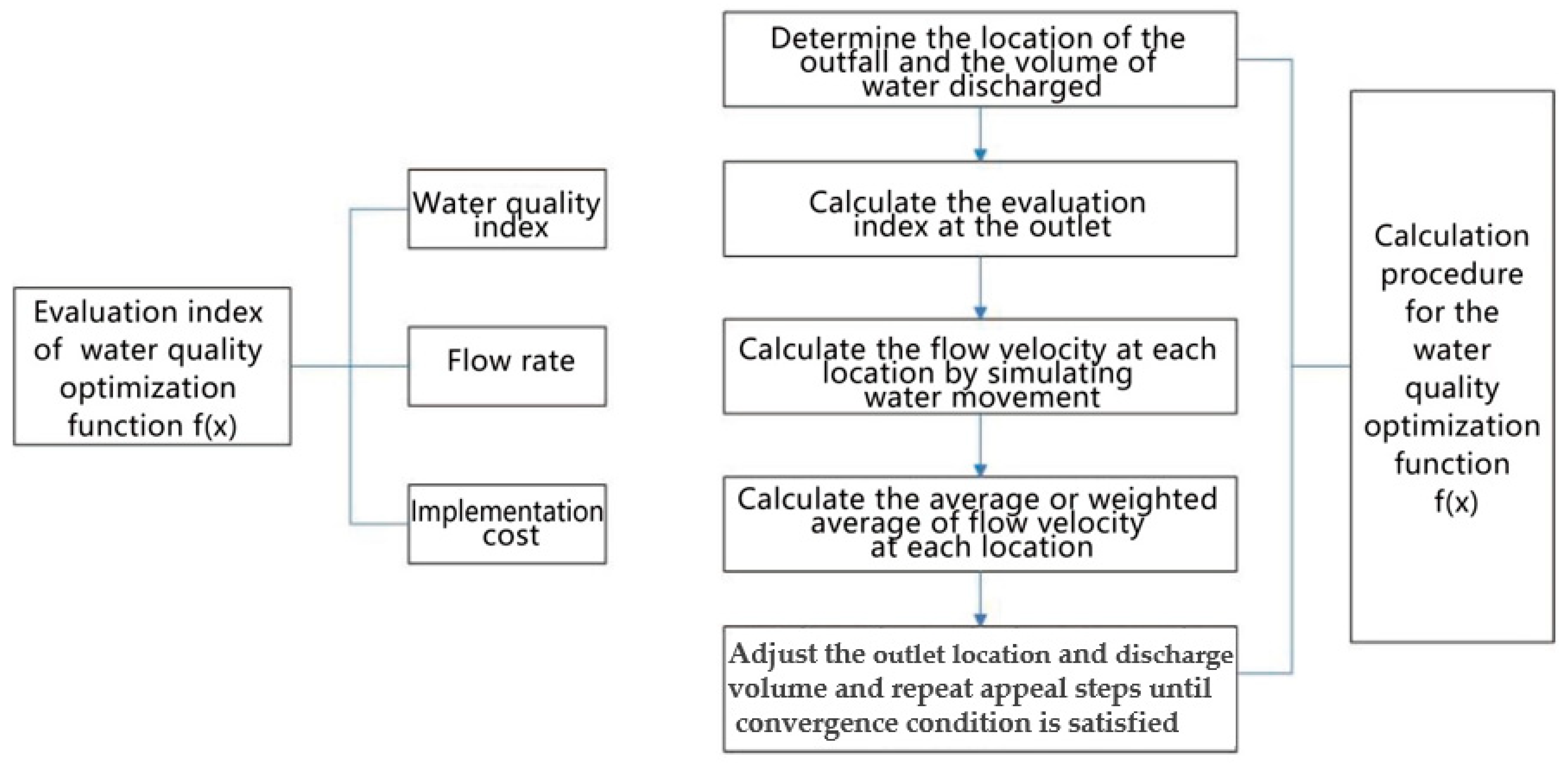
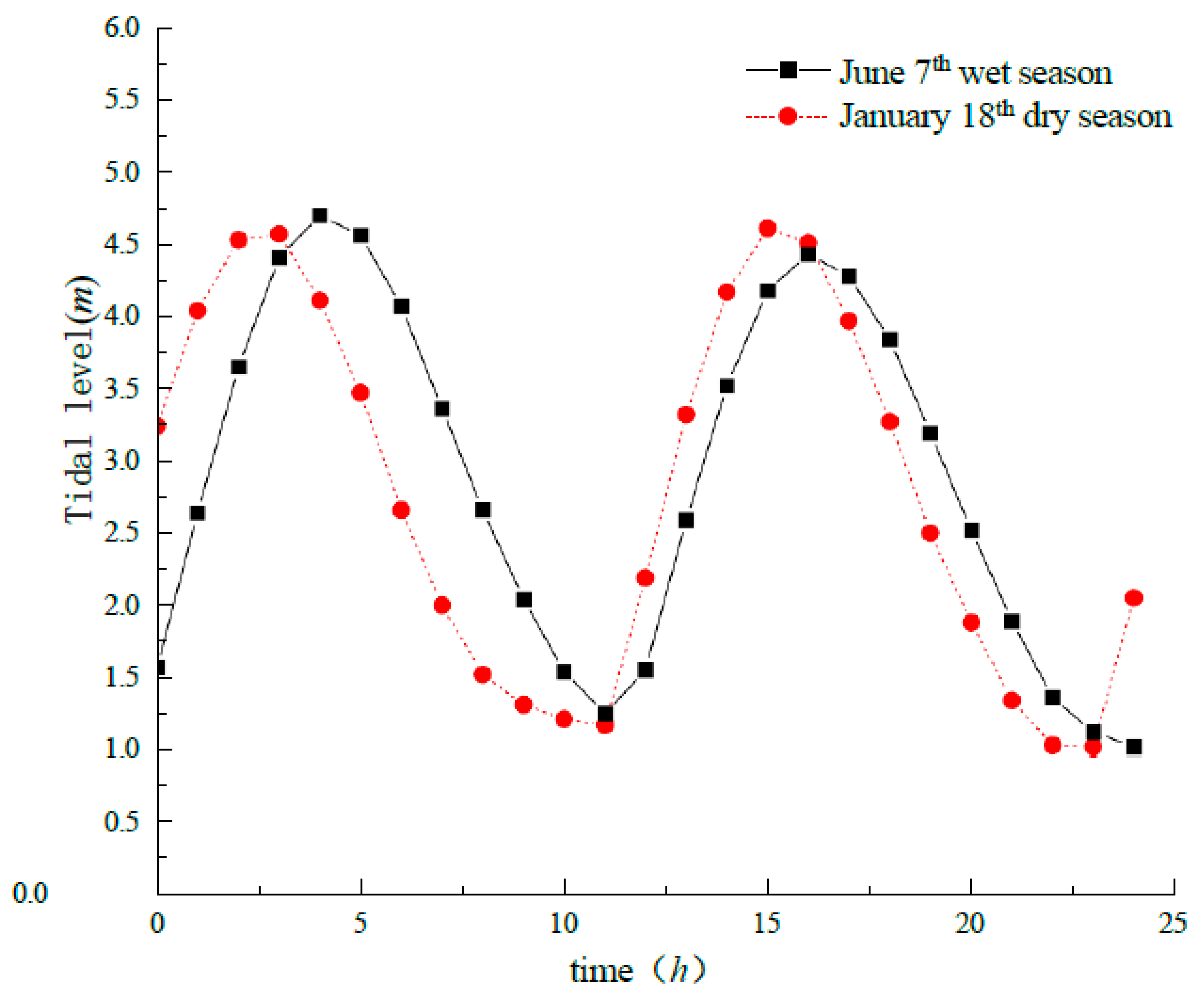

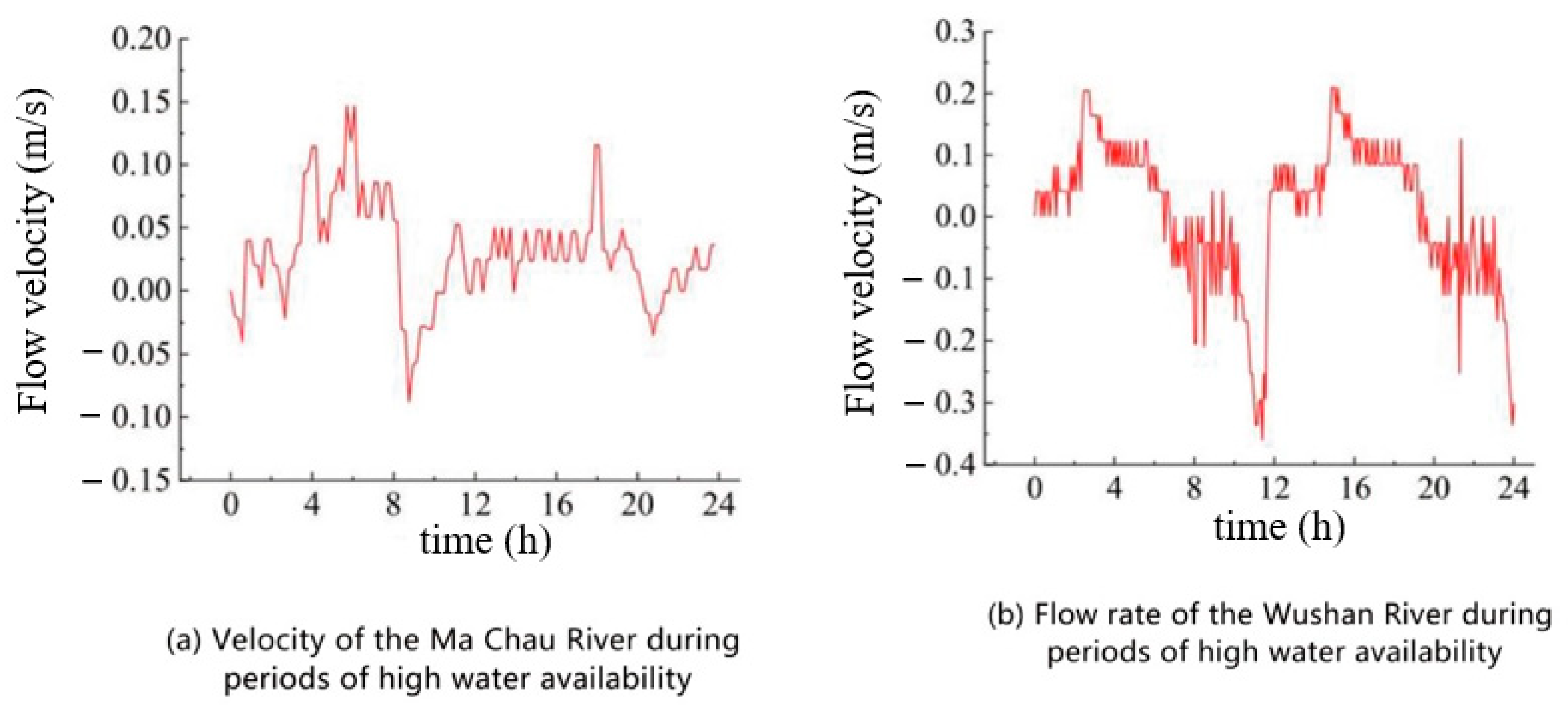
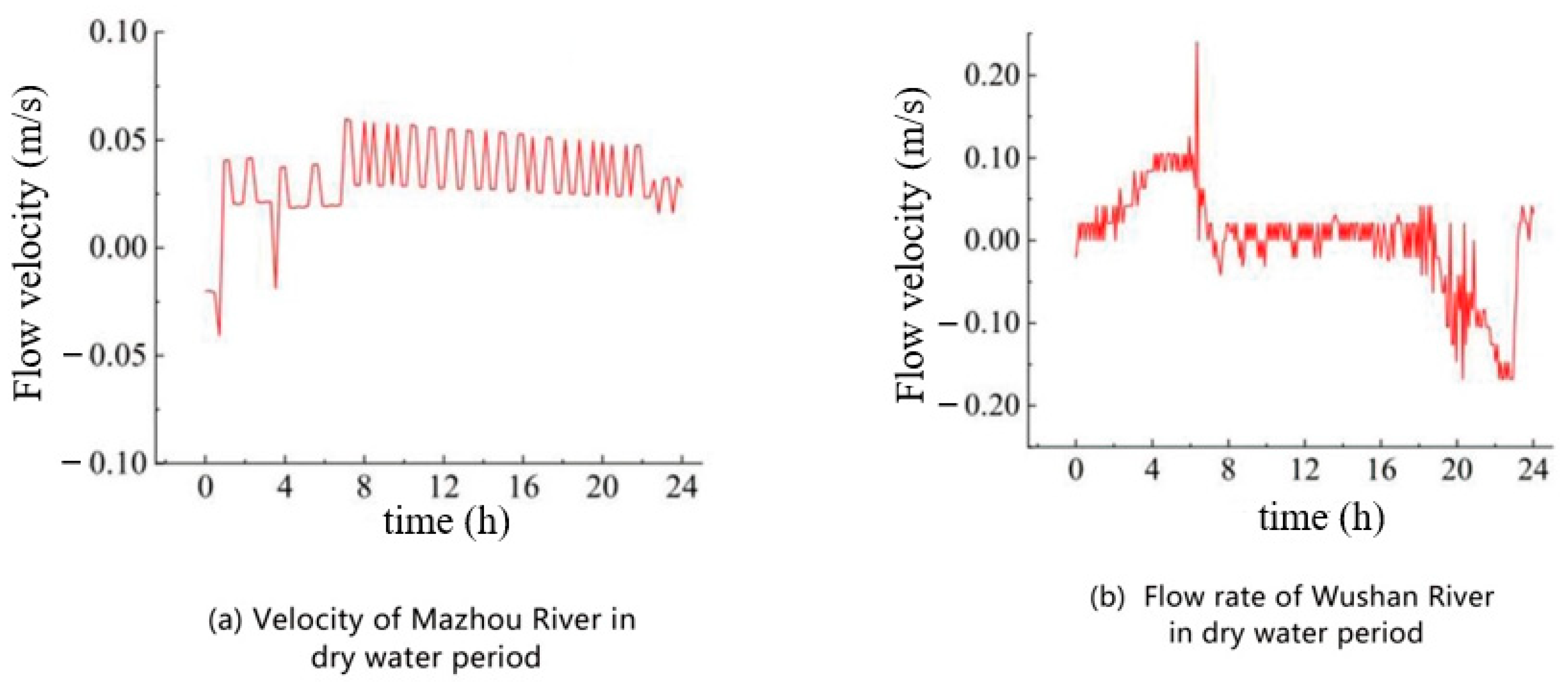
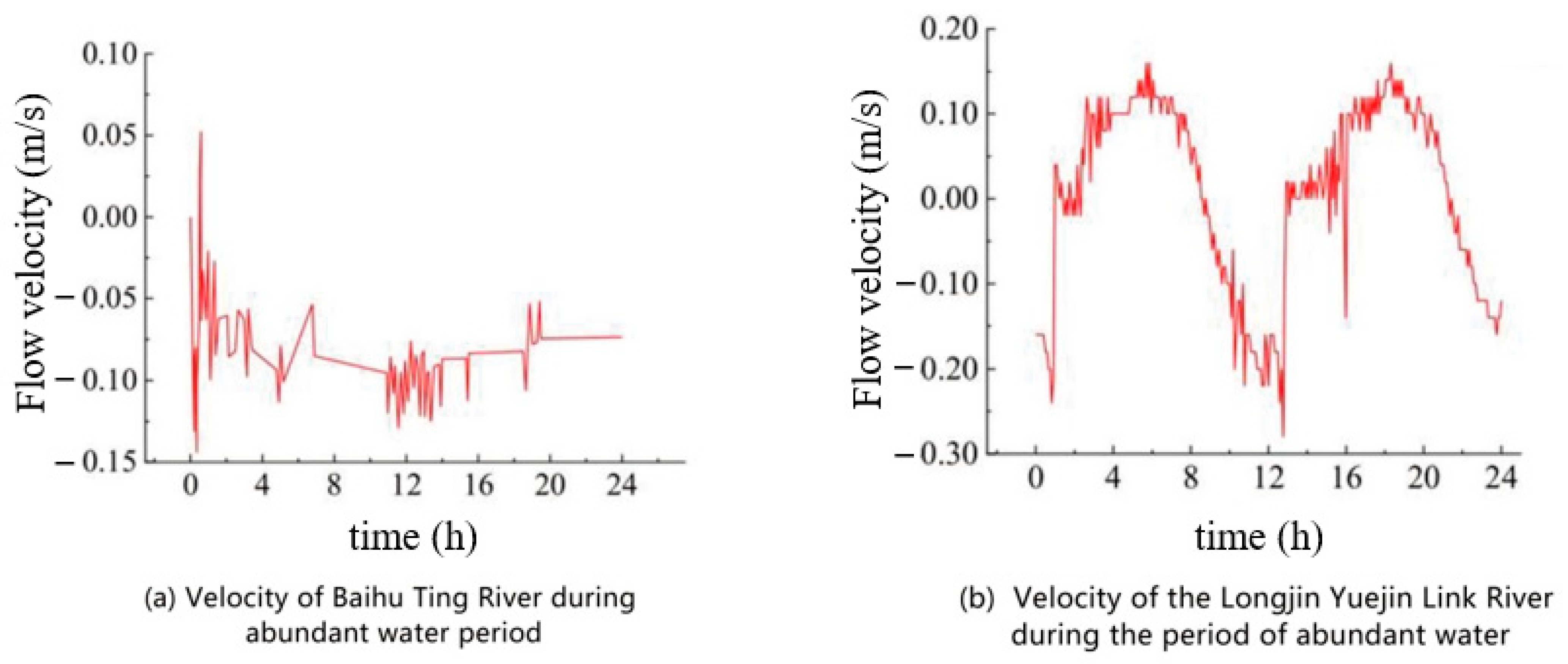
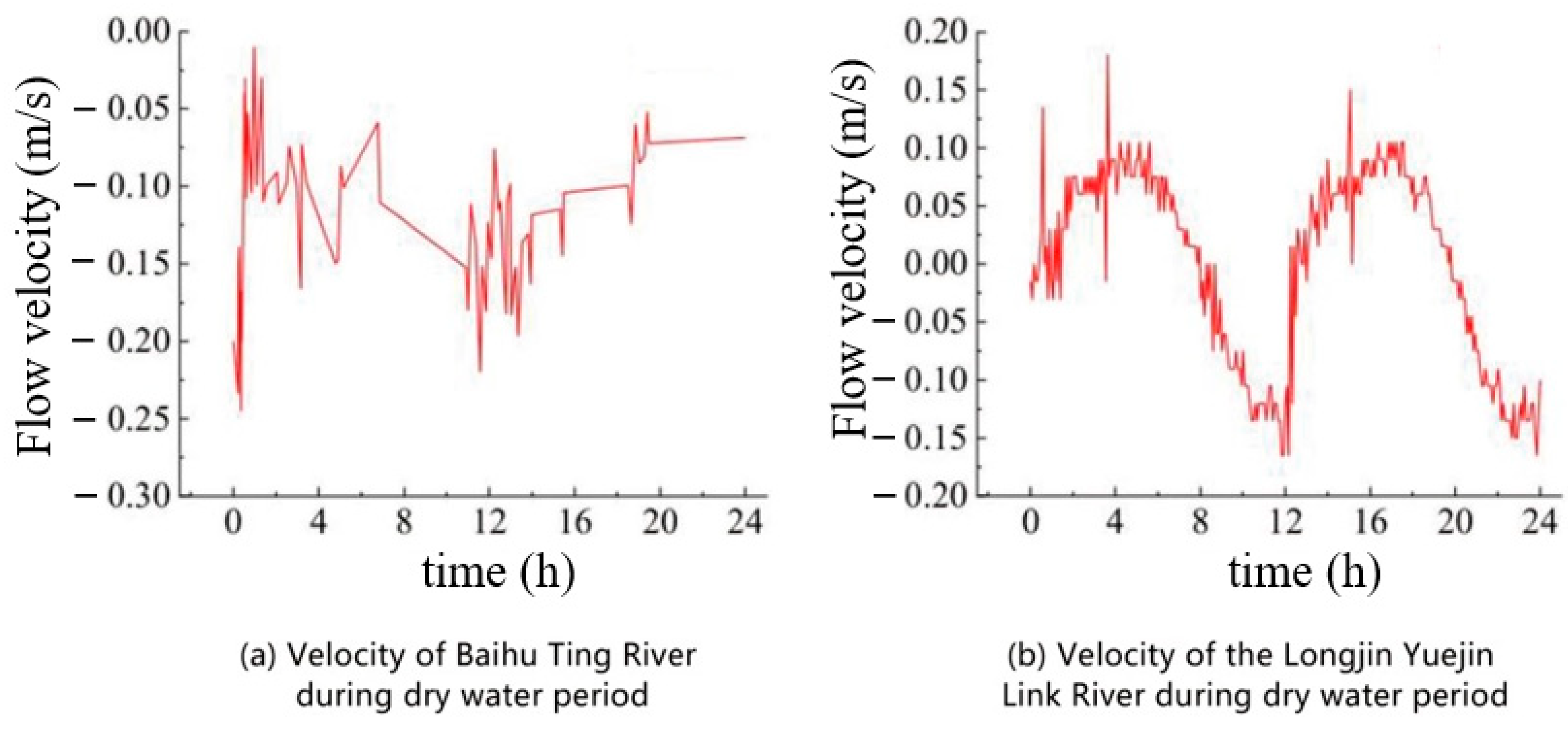
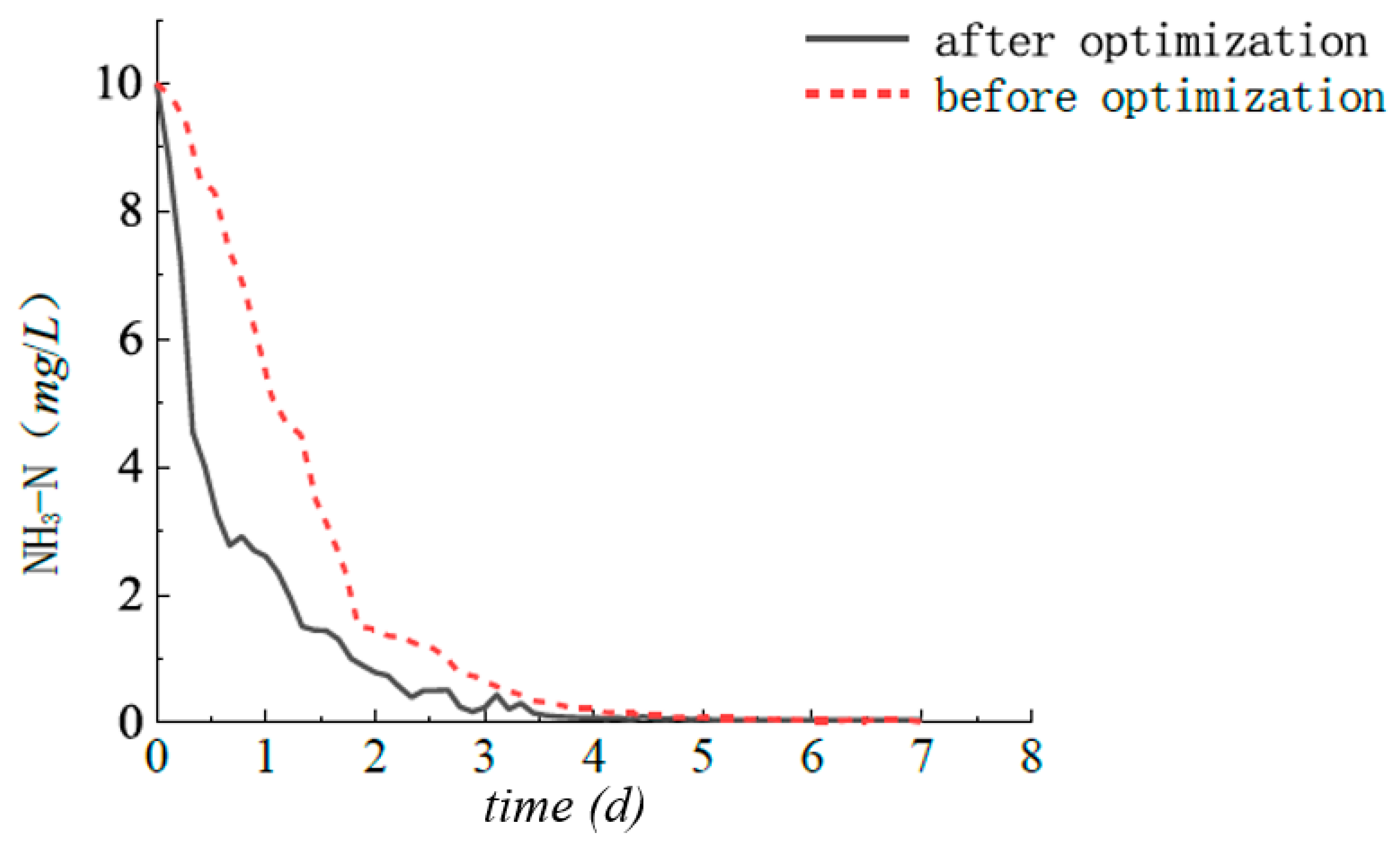


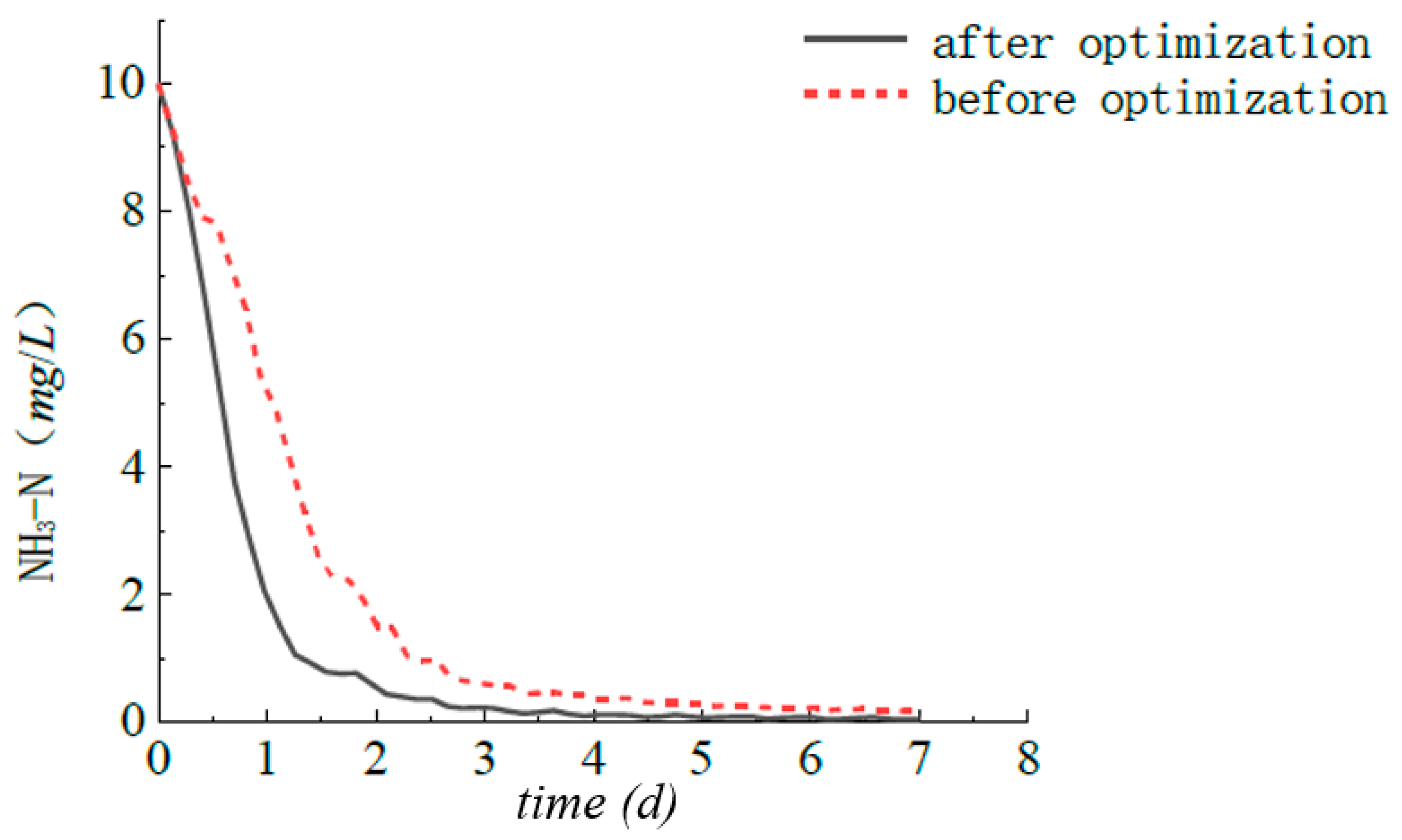

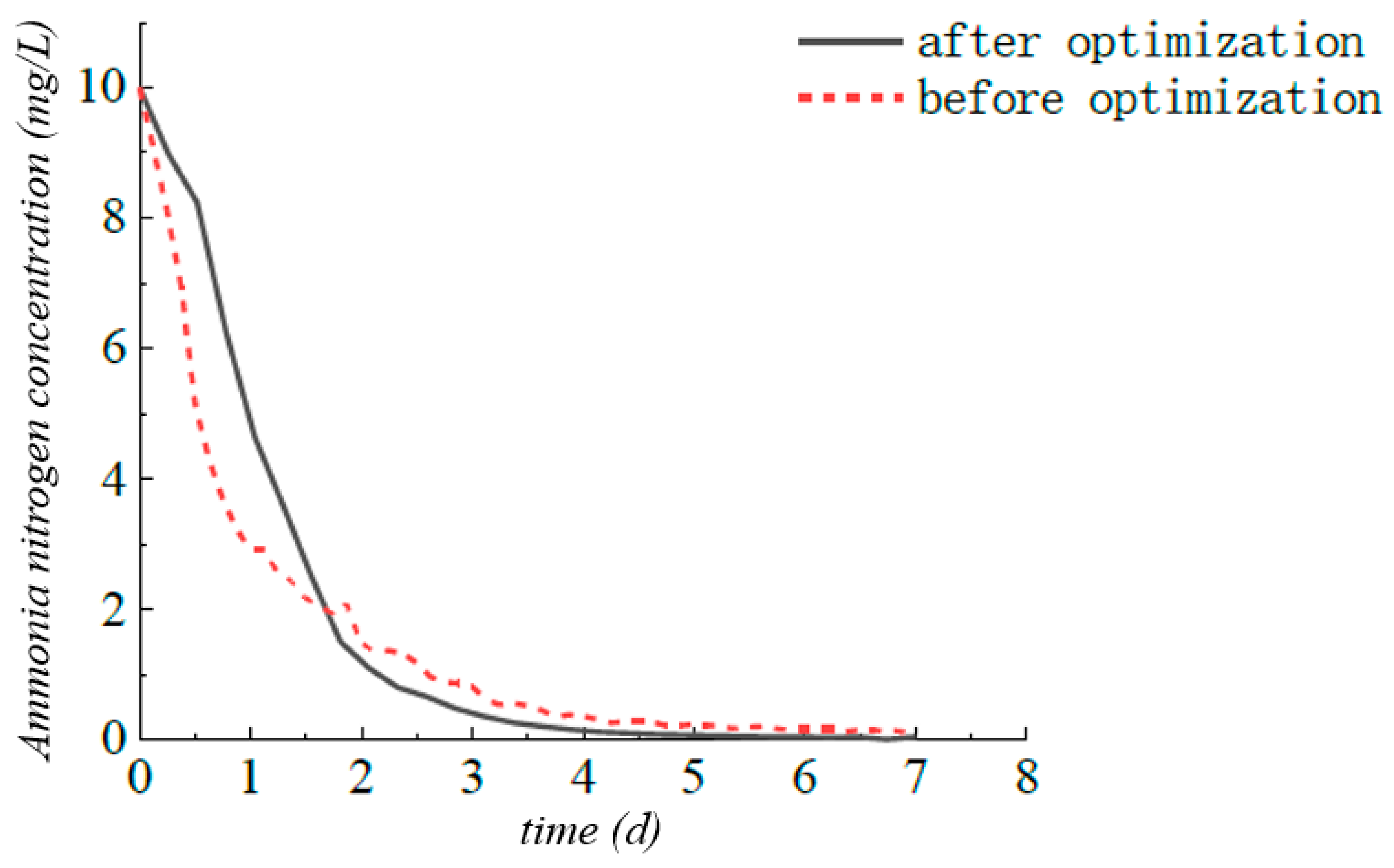
| Pumping Station | Lead-In Method | Design Flow Rate of Pumping Station (m3/s) |
|---|---|---|
| Gangtou Pumping Station | Sewerage | 6 |
| Yangqi Pumping Station | Draw water (for irrigation) | 18 |
| Baihu Pavilion Integrated Pumping Station | Sewerage | 8 |
| Yixing Recharge Pumping Station | Sewerage | 8 |
Disclaimer/Publisher’s Note: The statements, opinions and data contained in all publications are solely those of the individual author(s) and contributor(s) and not of MDPI and/or the editor(s). MDPI and/or the editor(s) disclaim responsibility for any injury to people or property resulting from any ideas, methods, instructions or products referred to in the content. |
© 2024 by the authors. Licensee MDPI, Basel, Switzerland. This article is an open access article distributed under the terms and conditions of the Creative Commons Attribution (CC BY) license (https://creativecommons.org/licenses/by/4.0/).
Share and Cite
Zhou, W.; Liao, W. Optimization of Ecological Dispatch and Hydrodynamic Improvements in Tidal River Channels Using SWMM Modeling: A Case Study of the Longjin Yangqi Area in Kurama Mountain. Water 2024, 16, 3336. https://doi.org/10.3390/w16223336
Zhou W, Liao W. Optimization of Ecological Dispatch and Hydrodynamic Improvements in Tidal River Channels Using SWMM Modeling: A Case Study of the Longjin Yangqi Area in Kurama Mountain. Water. 2024; 16(22):3336. https://doi.org/10.3390/w16223336
Chicago/Turabian StyleZhou, Wentao, and Weihong Liao. 2024. "Optimization of Ecological Dispatch and Hydrodynamic Improvements in Tidal River Channels Using SWMM Modeling: A Case Study of the Longjin Yangqi Area in Kurama Mountain" Water 16, no. 22: 3336. https://doi.org/10.3390/w16223336
APA StyleZhou, W., & Liao, W. (2024). Optimization of Ecological Dispatch and Hydrodynamic Improvements in Tidal River Channels Using SWMM Modeling: A Case Study of the Longjin Yangqi Area in Kurama Mountain. Water, 16(22), 3336. https://doi.org/10.3390/w16223336






